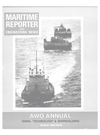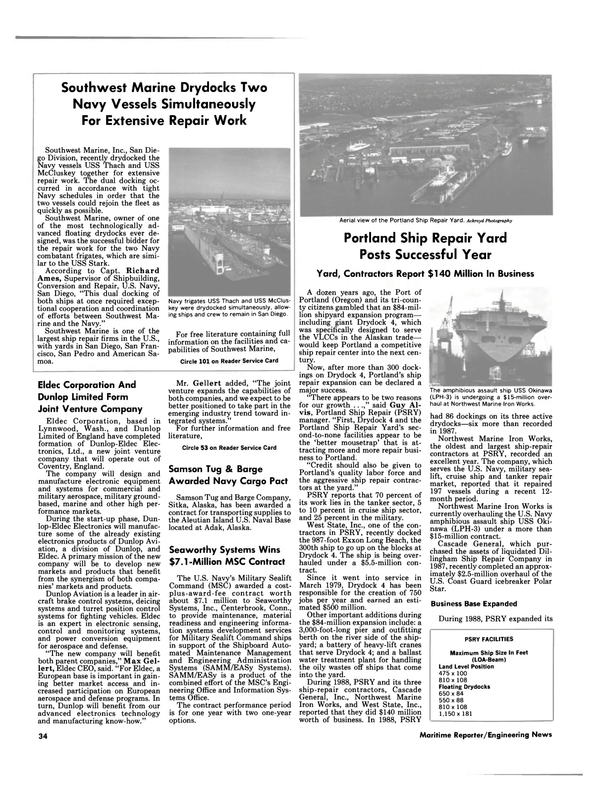
Portland Ship Repair Yard Posts Successful Year
Yard, Contractors Report $140 Million In Business A dozen years ago, the Port of Portland (Oregon) and its tri-county citizens gambled that an $84-million shipyard expansion program— including giant Drydock 4, which was specifically designed to serve the VLCCs in the Alaskan trade— would keep Portland a competitive ship repair center into the next century.
Now, after more than 300 dockings on Drydock 4, Portland's ship repair expansion can be declared a major success.
"There appears to be two reasons for our growth . ..," said Guy Alvis, Portland Ship Repair (PSRY) manager. "First, Drydock 4 and the Portland Ship Repair Yard's second- to-none facilities appear to be the 'better mousetrap' that is attracting more and more repair business to Portland.
"Credit should also be given to Portland's quality labor force and the aggressive ship repair contractors at the yard." PSRY reports that 70 percent of its work lies in the tanker sector, 5 to 10 percent in cruise ship sector, and 25 percent in the military.
West State, Inc., one of the contractors in PSRY, recently docked the 987-foot Exxon Long Beach, the 300th ship to go up on the blocks at Drydock 4. The ship is being overhauled under a $5.5-million contract.
Since it went into service in March 1979, Drydock 4 has been responsible for the creation of 750 jobs per year and earned an estimated $500 million.
Other important additions during the $84-million expansion include: a 3,000-foot-long pier and outfitting berth on the river side of the shipyard; a battery of heavy-lift cranes that serve Drydock 4; and a ballast water treatment plant for handling the oily wastes off ships that come into the yard.
During 1988, PSRY and its three ship-repair contractors, Cascade General, Inc., Northwest Marine Iron Works, and West State, Inc., reported that they did $140 million worth of business. In 1988, PSRY had 86 dockings on its three active drydocks—six more than recorded in 1987.
Northwest Marine Iron Works, the oldest and largest ship-repair contractors at PSRY, recorded an excellent year. The company, which serves the U.S. Navy, military sealift, cruise ship and tanker repair market, reported that it repaired 197 vessels during a recent 12- month period.
Northwest Marine Iron Works is currently overhauling the U.S. Navy amphibious assault ship USS Okinawa (LPH-3) under a more than $15-million contract.
Cascade General, which purchased the assets of liquidated Dillingham Ship Repair Company in 1987, recently completed an approximately $2.5-million overhaul of the U.S. Coast Guard icebreaker Polar Star.
Business Base Expanded During 1988, PSRY expanded its business beyond traditional ship repair.
Examples of this include layberthing (berthing and mooring ships for long periods of time) and conversion of Ready Reserve Force ships and layberthing large oil tankers that are in between charter assignments.
Portland's location, excellent mooring facilities, and the harbor's salt-free fresh water are assets that have attracted shipowners.
Another successful diversification effort has been the fabrication of oil field modules—high job-generating projects PSRY has done continuously since 1984.
A $12-million ARCO Alaska 1989 Sealift module project was recently awarded to Portland. The contract was awarded to Wright Schuchart Harbor Company of Seattle. The company will build five 1,500-ton modules, roughly the height of 11- story buildings.
In addition to PSRY's 24-acre module fabrication site adjacent to the shipyard, to support future work, an additional 30 acres in the Swan Island lagoon are being filled and developed for oil module fabrication projects.
Yard Rehabilitation Nears Completion A major rehabilitation of the older portion of PSRY that dates back to Henry J. Kaiser World War II shipbuilding is about 75 percent complete, according to Mr. Alvis.
Started in 1982, the $10-million rehabilitation project is a "selfhelp" program to be paid out of shipyard revenues.
The rehabilitated facilities support the Port's Drydocks 1 and 3.
The older part of PSRY was not included in the major PSRY $84- million ship-repair expansion program approved by Portland voters in 1976. That program provided Drydock 4, one of the largest of its kind on the West Coast, and its various support facilities and services which became operational in 1979.
"This rehabilitation is a joint effort of the Port (of Portland) and our ship-repair contractors to extend the useful life of the older part of the shipyard from our own revenues, without asking for additional tax," Mr. Alvis said.
He explained that four of the eight Washington cranes dating from World War II, manufactured in 1942, have been restored to like new condition. "Even though these cranes have given the Port 40 years of service, after total reconditioning, they are now new pieces of machinery with an expected service life of 20 years or more," he added.
In addition to reconditioning the cranes, the PSRY rehabilitation is making new ship berths out of old ones—with replacement of piling, decks, pavement, new lighting, new and improved utilities and sewer mains, river water systems and sprinkler improvements, new and vastly improved electrical substations, and a compressed air distribution system and enlarged equipment lay-down areas.
For free literature detailing the shipbuilding, repairing and conversion facilities of PSRY and its shiprepair contractors, C i r c l e 1 7 on Reader Service Card
Read Portland Ship Repair Yard Posts Successful Year in Pdf, Flash or Html5 edition of March 1989 Maritime Reporter
Other stories from March 1989 issue
Content
- HBC Barge Acquired By Trinity Industries page: 5
- Marine Interiors Offers Free Literature Listing Products And Services page: 6
- M a r i t i m e London 8 9 To Be Held April 17-21 In City Of London page: 6
- Swagelok Quick-Connects With Heavy-Duty Body Sleeve Now Available page: 8
- Palmer Offers Brochure On Cavitation-Reducing Polymer Coatings page: 8
- T w i n Disc Expands M a r i n e Transmission Series For Workboat Applications page: 9
- Soundcoat Offers Brochure On Vibration-Dissipating Noise Reduction Material page: 9
- N a u t i C a n Enterprises Reports Advanced Propeller Nozzle Improves Thrust, Lowers Drag page: 10
- Gladding-Hearn Announces Sale Of 3rd High-Speed Ferry For Great Lakes page: 10
- Avondale Boat Division Building 400-Passenger SES Ferry page: 11
- Lykes Names Two Senior VPs And Three New VPs page: 11
- Navigation & Communications Equipment Review page: 12
- N A V Y — A $35-BILLION ANNUAL MARKET page: 25
- MAJOR NAVY CONTRACTS page: 27
- ASNE-Mechanicsburg Section To Host Annual N a v a l Logistics Symposium In Carlisle, Pa., O n March 7 -9 page: 30
- Newest Navy Crane Ship Christened 'Diamond State' At Tampa Shipyards page: 31
- Southwest M a r i n e Drydocks Two N a v y Vessels Simultaneously For Extensive Repair Work page: 34
- Portland Ship Repair Yard Posts Successful Year page: 34
- Eldec Corporation And Dunlop Limited Form Joint Venture Company page: 34
- Dampa Appoints Hopeman Brothers Sole U.S. Distributor page: 35
- Compass Display Protected From Abrasion By Coating page: 36
- ABS Forms Corporate Quality Assurance Group page: 36
- Imperial Immersion Suits Save Lives; Survivors Get Club Membership page: 36
- SSE Launches New Class Corvette For Singapore Navy page: 38
- L&C Associates Offers Brochure On Marine Dehumidification Service page: 38
- Rolla's New Five-Bladed REXP5 Propeller Represents Breakthrough In Design page: 38
- Cargocaire Introduces Marine Dehumidifier page: 39
- Marinette Marine Tests MCM-2 Propulsion Plant page: 40
- New Generator Line From Marathon Electric page: 40
- Pan American Hovercraft Offers Color Brochure On New Design Hovercraft page: 43
- VPSI Completes Crankshaft Contract page: 43
- A W O Acclaimed For Quick, Decisive Action To Combat Drought Effects page: 44
- CABOTAGE: I N THE INTEREST OF N A T I O N A L DEFENSE A ND COMMERCE page: 46
- SUCCESS O N TAX FRONT DOMINATED 100TH CONGRESS page: 47
- W O R K I N G TOWARD CLEAN AIR A ND CLEAN WATER page: 49
- Muller Appointed Assistant VP-Operations At Moran Towing page: 51
- A W O Annual M e e t i n g To Be Held In Washington, D.C. April 6 -7 page: 51
- Literature Available On Circle Seal's Plastic Inline Check/Relief Valves page: 51
- New Commuting Service Begins Between New Jersey And New York page: 51
- New Engine Analyzer Reduces Fuel Costs On Marine Diesels page: 52
- American United Marine Wins Achievement Award For TFC Compactor Sales page: 52
- First U.S. Commercial SWATH To ABS Class Under Construction page: 53
- Unitor Ship's Hospital, Safety And Maintenance Equipment Chosen For 'Royal Viking Sun' page: 53
- Aluminum Boats Delivers 150-Passenger Excursion Boat To Maryland Tours page: 63
- Alfa Products Introduces New Boat Bilge Cleaner —Literature Available page: 63


